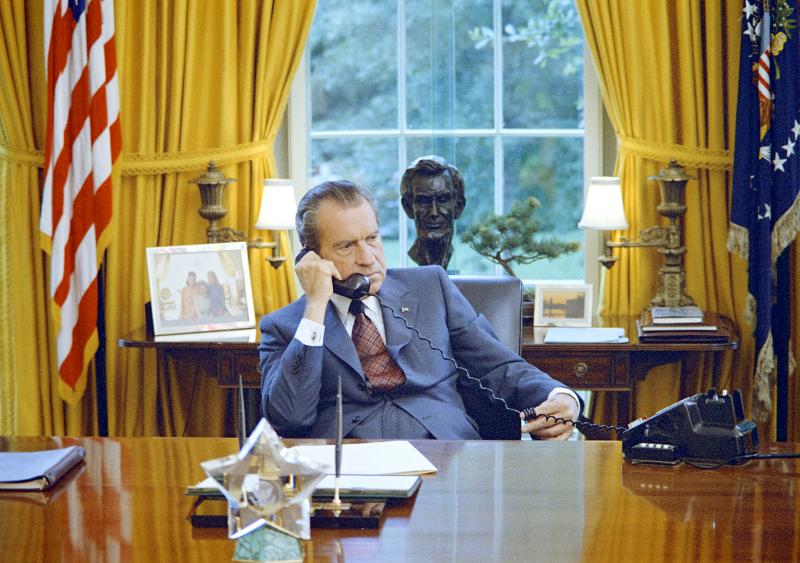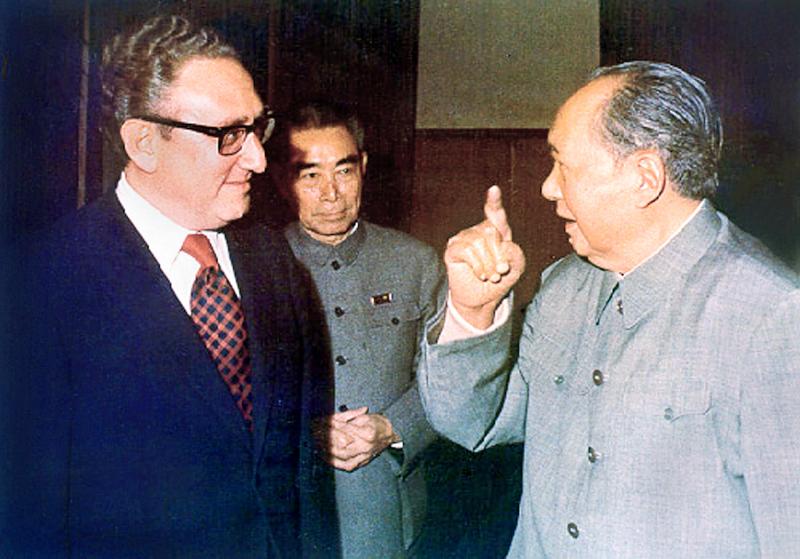US president Richard Nixon had a lot on his mind in the spring of 1971. The Watergate break-in that would ultimately bring down his presidency was more than a year away, but he had a full foreign policy plate with an unpopular war in Vietnam, tensions in the Middle-East and stalled efforts to bring Moscow to the table for talks on limiting nuclear arms.
One other foreign policy challenge, not then publicly known, was the tantalizing prospect of rapprochement with communist China after two decades of estrangement. Nixon and his national security advisor, Henry Kissinger, both believed a breakthrough with “Red China” would increase their leverage in peace talks with the North Vietnamese and arms talks with Moscow.
Something else weighed heavily on Nixon’s mind at that time. Opening up dialog with Beijing might come at the expense of the Republic of China (ROC) on Taiwan. Nixon, who had based his political career on being a staunch opponent of Communism, was a personal friend of the-then 83-year-old Chinese Nationalist Party (KMT) leader Chiang Kai-shek (蔣介石), whom Nixon fondly referred to as “the old man.”

Photo courtesy of Wikimedia Commons
‘WHAT’S BEST FOR US’
In a phone call with Kissinger on the evening of April 14 — the same day TV networks reported on the US ping pong team being invited to China — Nixon expressed his concern over Taiwan’s future.
“The Taiwan thing, that’s sort of worrisome, I don’t know if there’s a damn thing we can do about it, is there?” he asked of Kissinger, who replied: “It’s a tragedy that it had to happen to Chiang at the end of his life, but we have to be cold about it.”

Photo courtesy of Wikimedia Commons
Nixon concurred, adding: “We have to do what’s best for us.”
On July 17, two days after announcing he would make an historic “journey for peace” to Beijing the following year, Taiwan was again on his mind.
“[The president] also brooded some again today, as he does frequently, about the question of how Taiwan can survive now, and that obviously really concerns him,” White House chief of staff H.R. (Bob) Haldeman noted in his diary entry that day.
During his 17 hours of secret meetings with Chinese Premier Chou Enlai (周恩來) in Beijing earlier that month, Kissinger pushed back when Chou tried to link US recognition that Taiwan was “a province of China” as a precondition of Nixon’s visit. However, Kissinger seemed to acquiesce on Chou’s insistence that the visit should set recognition as the “ultimate direction” of US policy.
In his July 14 memo to Nixon on the Chou meeting, Kissinger wrote: “He accepted my position that some time would be required, ie, well into your second term.”
The implication was that, in Nixon’s second term, Taiwan would be abandoned. Haldeman said as much in his July 17 diary entry.
“No promises have been made and no commitments have been made to the Chinese that have to be delivered prior to 1972. But after that, it’s inevitable that Taiwan is going to have to become a province of China or something of that sort. And it does pose a problem especially since the President has been an old China hand from way back — a free China hand, that is,” Haldeman said.
WATERGATE SCANDAL
Although Nixon won the 1972 election in a landslide, the unraveling Watergate scandal would soon consume his presidency and he resigned on Aug. 9, 1974.
In Beijing, communist Chinese leader Mao Zedong (毛澤東) was doing some brooding of his own. Kissinger, who met Mao again on Nov. 12, 1973, noted the chairman’s bafflement at how a “minor incident” like Watergate could cause the “destruction of a strong president.”
“Why is it in your country, you are always so obsessed with that nonsensical Watergate issue? Anyway, we are not happy about it,” Mao said, in slurred speech that was interpreted by his translator.
In the same meeting, Mao admitted Beijing’s relationship with Taiwan was “quite complex,” adding a comment that would have made the US delegation very uncomfortable: He did not believe in a peaceful transition.
“They are a bunch of counter revolutionaries. How could they cooperate with us? I say that we can do without Taiwan for the time being, and let it come after 100 years,” Mao was quoted saying in the official Department of State transcript of the meeting.
Kissinger, who by then was also serving as Nixon’s Secretary of State, replied that the US wanted diplomatic relations with the People’s Republic but that the “current domestic situation” — a probable reference to Watergate, as well as the strong support for Taiwan in Congress — meant that the US could not “immediately sever relations with Taiwan.”
Subsequent high level meetings between US and Chinese leaders would see the same “excuse” given as to why the current administration could not immediately sever relations with Taiwan.
In a meeting with Chinese Vice Premier Deng Xiaoping (鄧小平) on Dec. 4, 1975, Nixon’s successor, president Gerald Ford, said: “We are very grateful that you are understanding of the domestic political situation in the United States.”
When Deng repeated Mao’s earlier assertion that Beijing did not believe in a peaceful transition, and noted Kissinger’s repeated references to Mao’s 100 year time frame, Ford said to laughter: “You can argue that 100 years is a peaceful transition.”
Prior to president Ford’s China visit, Kissinger had met with the Chinese leadership on Oct. 21 that year, accompanied by Ambassador George H. W. Bush and State Department official Winston Lord, who described the meeting as “disturbing,” citing the Chinese perception that the US had become “unreliable” and was a “fading strategic power in the face of Soviet advance.”
Lord’s memo on the meeting, which was handed to president Ford by Kissinger, made the following recommendation on Taiwan: “For now it is better to have the US keep the island under control rather than having it go independent or toward Moscow or Tokyo. The Chinese can wait patiently until the time is ripe, but then they will have to use force ... the US should not ask for peaceful assurances, but it can take its time letting Taiwan go.”
It would be Jan. 1, 1979 before the US would eventually cut diplomatic ties with Taiwan in favor of Beijing, a unilateral move taken by then-president Jimmy Carter, but he too could not ignore the Taiwan-friendly US Congress, which passed the Taiwan Relations Act that ensured the US would provide Taipei with defensive weapons, a move that infuriated Beijing.
Carter only served one term and his successor, Ronald Reagan, was a staunch supporter of Taiwan. During the 1980 election campaign Reagan even threatened to reverse Carter’s decision to cut ties with Taipei, but once in the White House Reagan stuck to the “one China” policy.
In the intervening decades, Taiwan was able to build what has become known as its “silicon shield” — the state-of-the-art semiconductor industry that supplies more than half of the world’s advanced chips — essentially protecting it from the threat of a Chinese military attack.
But the break-in at Washington’s Watergate hotel on June 17, 1972 may well have saved Taiwan from being handed over to China by Kissinger and Nixon.
Craig Addison is writer/producer of Nixon’s China Choice, a podcast docudrama (nixonschinachoice.podbean.com) that tells the behind-the-scenes story of Richard Nixon and Henry Kissinger’s secret diplomacy with China in 1971, and how Taiwan was a pawn in the big game.

Most heroes are remembered for the battles they fought. Taiwan’s Black Bat Squadron is remembered for flying into Chinese airspace 838 times between 1953 and 1967, and for the 148 men whose sacrifice bought the intelligence that kept Taiwan secure. Two-thirds of the squadron died carrying out missions most people wouldn’t learn about for another 40 years. The squadron lost 15 aircraft and 148 crew members over those 14 years, making it the deadliest unit in Taiwan’s military history by casualty rate. They flew at night, often at low altitudes, straight into some of the most heavily defended airspace in Asia.

Taiwan’s democracy is at risk. Be very alarmed. This is not a drill. The current constitutional crisis progressed slowly, then suddenly. Political tensions, partisan hostility and emotions are all running high right when cool heads and calm negotiation are most needed. Oxford defines brinkmanship as: “The art or practice of pursuing a dangerous policy to the limits of safety before stopping, especially in politics.” It says the term comes from a quote from a 1956 Cold War interview with then-American Secretary of State John Foster Dulles, when he said: ‘The ability to get to the verge without getting into the war is

Beijing’s ironic, abusive tantrums aimed at Japan since Japanese Prime Minister Sanae Takaichi publicly stated that a Taiwan contingency would be an existential crisis for Japan, have revealed for all the world to see that the People’s Republic of China (PRC) lusts after Okinawa. We all owe Takaichi a debt of thanks for getting the PRC to make that public. The PRC and its netizens, taking their cue from the Chinese Communist Party (CCP), are presenting Okinawa by mirroring the claims about Taiwan. Official PRC propaganda organs began to wax lyrical about Okinawa’s “unsettled status” beginning last month. A Global

Like much in the world today, theater has experienced major disruptions over the six years since COVID-19. The pandemic, the war in Ukraine and social media have created a new normal of geopolitical and information uncertainty, and the performing arts are not immune to these effects. “Ten years ago people wanted to come to the theater to engage with important issues, but now the Internet allows them to engage with those issues powerfully and immediately,” said Faith Tan, programming director of the Esplanade in Singapore, speaking last week in Japan. “One reaction to unpredictability has been a renewed emphasis on